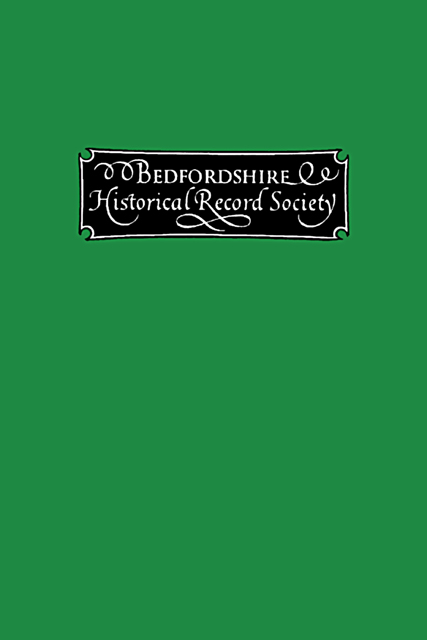Book contents
- Frontmatter
- Contents of Volume II
- Rules for Transcription
- Corrections and Additions to Volume i
- Frontispiece : Seal of Hugh de Beauchamp to face In Memoriam C. G. C
- The Bedfordshire Wills and Administrations proved at Lambeth Palace and in the Archdeaconry of Huntingdon
- The Beauchamps, Barons of Eaton
- Ancient Bedfordshire Deeds, No. I
- Records of Northill College, No. II.
- Bedfordshire Charters in the Missenden Cartulary
- The Browne Family of Arlesey
- Markets and Fairs of Luton
- The Assessment of Knight Service in Bedfordshire, No. I
- Materies Genealogica, No. I
- An Early Bedfordshire Taxation
- A Commutation of Villan Service
- Records of Knight Service in Bedfordshire
- Notes and Replies: —Ravensden and Chainhalle: G. H. F.—Toddington Place Names, 1453 : F. A. P-T.— Luton Names in the xiith Century : G. FI. F.—Duties on Bricks : H. S. Holt
- Index
The Beauchamps, Barons of Eaton
Published online by Cambridge University Press: 14 July 2023
- Frontmatter
- Contents of Volume II
- Rules for Transcription
- Corrections and Additions to Volume i
- Frontispiece : Seal of Hugh de Beauchamp to face In Memoriam C. G. C
- The Bedfordshire Wills and Administrations proved at Lambeth Palace and in the Archdeaconry of Huntingdon
- The Beauchamps, Barons of Eaton
- Ancient Bedfordshire Deeds, No. I
- Records of Northill College, No. II.
- Bedfordshire Charters in the Missenden Cartulary
- The Browne Family of Arlesey
- Markets and Fairs of Luton
- The Assessment of Knight Service in Bedfordshire, No. I
- Materies Genealogica, No. I
- An Early Bedfordshire Taxation
- A Commutation of Villan Service
- Records of Knight Service in Bedfordshire
- Notes and Replies: —Ravensden and Chainhalle: G. H. F.—Toddington Place Names, 1453 : F. A. P-T.— Luton Names in the xiith Century : G. FI. F.—Duties on Bricks : H. S. Holt
- Index
Summary
While the Beauchamps of Bedford, tenants in chief of huge estates, can be traced fairly easily from about 1130, the Eaton line presents much greater difficulty; their smaller possessions and their less importance mean less frequent mention in the Rolls. Even now, after a good deal of serious research, two most important points —the exact relation of this family to the Beauchamps of Bedford, and the exact method by which their Barony was acquired—remain obscure. But one may hope at least that the ground has been partially cleared for future students.
The starting point of the pedigree was furnished by the charters of Wardon Abbey and of Bushmead Priory, upon which a framework of the generations before 1200 was built; into this, entries from the Rolls and similar sources have been fitted as dates allowed. This part of the pedigree must therefore be regarded as tentative, but from Hugh IV E onwards the path seems to be fairly clear, so far as it has been traced, that is, up to the sale of the family estates. A very incomplete pedigree, incorrect at one step, was made for Sir R. Cotton, to which no further reference need be made. Another seems to have been compiled by Sir Richard Saint George, Clarenceux King; and no doubt there are many others, similarly incomplete owing to the inaccessibility of the Rolls until recent time.
For the same reason, later writers will doubtless criticise the present account as anything but exhaustive; there are several men, fairly obviously cadets or off-shoots of this family, who cannot at present be fitted into the pedigree. The main line, however, has at last been disentangled from the Beauchamps of Bedford, and the story is fairly complete down to the sale of the barony, so far as the Bedfordshire lands are concerned. Outside the county (and they held land in at least Essex, Hertfordshire, and Huntingdonshire), the present writer has not dared to follow them; local knowledge alone can help in such a case.
In the Wardon Cartulary are two notes, apparently written in the xvth century, which concern this family, and are here translated.
- Type
- Chapter
- Information
- Publisher: Boydell & BrewerFirst published in: 2023



